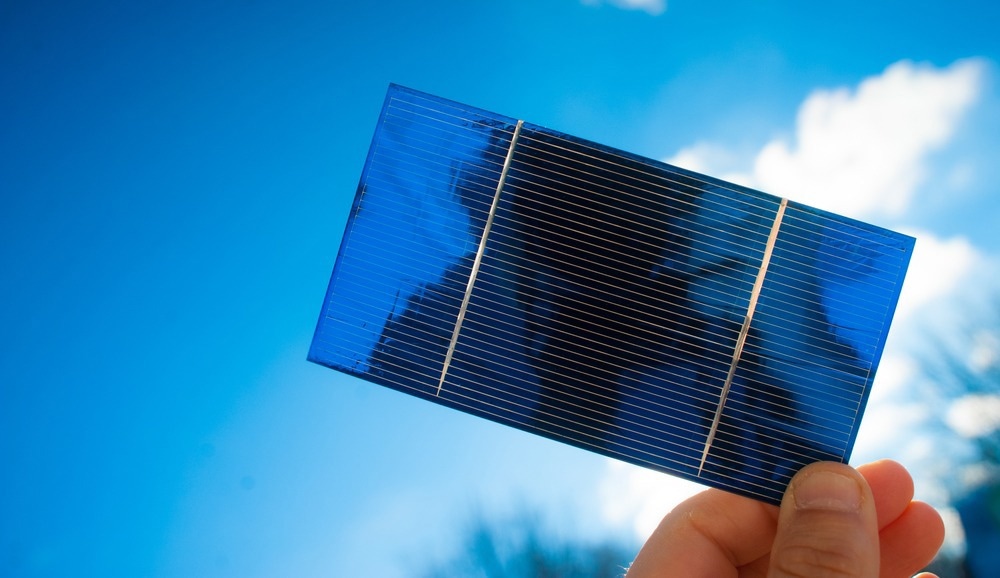Photovoltaics has evolved through three generations, the most recent being third-generation solar cells (dye-sensitized solar cells, DSSCs), which primarily include advanced nanomaterials and promise to reduce the cost of solar cell manufacture.

Image Credit: Dave Weaver/Shutterstock.com
What are Dye-Sensitized Solar Cells (DSSCs)?
DSSCs are semi-transparent, flexible, and efficient thin film solar cells that enable a variety of applications not possible with rigid silicon-based photovoltaic systems. DSSCs function even in low-light and overcast conditions. Furthermore, they are cheaper, simpler to produce, compatible with flexible substrates, and, most crucially, absorb more sunlight per surface area than ordinary silicon-based solar panels. Based on a porphyrin dye in liquid electrolyte DSSCs, a power conversion efficiency (PCE) of up to 13% was reported in 2014.
Structure and Working Principle of DSSCs
A standard DSSC is made up of transparent conducting oxide (TCO) glass substrates, dye, photoanode (typically titanium dioxide (TiO2) nanoparticle), electrolytes, and platinum-based counter electrode. The working mechanism is as follows: first, sunlight enters through the transparent electrode and excites the electrons in the dye layer, which then flow into the conduction band of TiO2. These electrons are taken through an external circuit. After passing through the external circuit, they are fed into the counter electrode and flow into the electrolyte. The electrolyte then delivers the electrons back to the dye molecules, regenerating the oxidized dye.
DSSCs have not yet achieved the efficiency levels of commercially available Si-based solar cells (over 25%), but with the help of nanotechnology, they have the potential to achieve higher efficiency than Si-based solar cells. Novel nanostructures, particularly graphene and its derivatives, quantum dots, and MXenes, are more appealing due to their superior optoelectronic, mechanical, thermal, and chemical properties.
Graphene in Dye-Sensitized Solar Cells
One of the most common transparent electrodes is indium tin oxide (ITO). ITO films, on the other hand, are typically brittle and unstable at high temperatures. Because of its high electron mobility and transparency (>90%), graphene is being explored as a possible replacement material to address the cost and performance restrictions of ITO. Researchers have previously achieved a PCE of 8.44% by using graphene-based materials as transparent conducting electrodes, outperforming devices based on standard ITO transparent electrodes.
The mesoporous semiconducting layer in a DSSC plays a vital role in the photon-to-electricity conversion process. Graphene is considered a suitable nanomaterial for incorporation into semiconducting layers because its energy level is between the conduction bands of TiO2 and FTO. This property allows for the effective passage of electrons from TiO2 to FTO, improving the performance of DSSCs. Researchers found that using rGO-TiO2 composite as a semiconducting layer increased photocurrent by 29%.
The counter electrode in DSSCs captures electrons from the external circuit and injects them into the electrolyte. Graphene has great electrocatalytic activity and excellent conductivity, making it a possible candidate for Pt as a counter electrode.
Quantum Dots Sensitized DSSCs
Quantum dots are semiconductor nanoparticles with sizes ranging from 2 to 20 nm that exhibit unusual behavior due to a phenomenon known as quantum confinement. Fourth-generation solar cells include quantum dot sensitized solar cells (QDSSC). These solar cells, like their predecessor DSSC, contain a photoanode, a cathode, and an electrolyte, with the exception of the photosensitizer, which is a layer of quantum dots such as CdS, CdSe, and CdTe, as well as graphene quantum dots (GQDs). For example, GQDs increased PCE by 8.9% compared to 7.6% for traditional N719 dyes.
MXenes in Dye-Sensitized Solar Cells
The most expensive component in DSSCs by far is the counter electrode (platinum), including the catalyst layer and the transparent conducting oxide (TCO) layer. The prospective layer replacement would open the path for the broad commercialization of DSSC technology.
MXenes have recently gained a lot of attention because of their huge surface area, thermal and electrical conductivity, biocompatibility, strong catalytic activity, and flexibility. MXene-based counter electrode has been shown to have a remarkable 8.68% conversion efficiency, exceeding typical Pt-based counter electrode by 4.03%.
Commercial Adoption of Nanotechnology in Solar Cells
Recently, a pilot project of Graphene Flagship built the world's first big area (0.5 m2) graphene-enabled perovskite solar panels, each having 40 modules. The solar farm was successfully installed on the Greek island of Crete, and it comprises nine graphene-perovskite panels with a total panel size of 4.5 m2, a total peak power production of more than 250 Watt, and an excellent PCE of 12.5%. The project intends to lower the levelized cost of energy to less than 20€/MWh.
Another commercial example of using nanotechnology in solar cells comes from a collaboration in 2018 between ZNShine and Bharat Heavy Electrical Limited, where they put graphene coating on a sunlight-facing panel to operate as a self-cleaning coating and enhance power conversion efficiency.
Some of the most well-known nanotechnology-based solar cell producers include Trina Solar, Solargise, Jinko Solar, NextEra Energy, First Solar Inc., Canadian Solar, and Hanwha-Q Cells.
Reference and Further Reading
Pescetelli, Sara, et al. (2022) Integration of two-dimensional materials-based perovskite solar panels into a stand-alone solar farm. Nature Energy, 7, pp. 597–607. https://doi.org/10.1038/s41560-022-01035-4
Muchuweni, Edigar, et al. (2020). Recent advances in graphene-based materials for dye-sensitized solar cell fabrication. RSC advances. 10(72), pp. 44453–44469. https://doi.org/10.1039/D0RA08851J
Zhang, Ye, et al. Recent applications of graphene in dye-sensitized solar cells. Current Opinion in Colloid & Interface Science. 20(5-6) pp. 406–415. https://doi.org/10.1016/j.cocis.2015.11.002
Ahmad, Muhammad Shakeel, et al. (2021) 2-D Mxene flakes as potential replacement for both TCO and Pt layers for Dye-Sensitized Solar cell. Ceramics International. 47(19), pp. 27942-27947. https://doi.org/10.1016/j.ceramint.2021.06.225
Janani, Murugesan, et al. (2017). Photovoltaics: Role of Nanotechnology in Dye‐Sensitized Solar Cells. Nanotechnology for Energy Sustainability. https://doi.org/10.1002/9783527696109.ch5
Souter, W. (2013) What is a Dye Sensitized Solar Cell? AzoNano [online] Available at https://www.azonano.com/article.aspx?ArticleID=3175
Disclaimer: The views expressed here are those of the author expressed in their private capacity and do not necessarily represent the views of AZoM.com Limited T/A AZoNetwork the owner and operator of this website. This disclaimer forms part of the Terms and conditions of use of this website.